Payroll
More Hours Worked in June as Businesses Start Reopening
“The jobs index moved very little from May, but increases in wages and hours worked signal significant improvements in small business labor utilization in June,” said James Diffley, chief regional economist at IHS Markit.
Jul. 01, 2020

The latest Paychex | IHS Markit Small Business Employment Watch shows that employment growth held steady in June, with the jobs index moderating just 0.06 percent to 94.81. However, increases in weekly earnings signify an upward trend as more businesses reopened their doors, and employees resumed work. As such, annualized one-month growth in weekly hours worked reached 8.28 percent in June; weekly earnings growth rose to 4.02 percent; and hourly earnings growth increased to 3.46 percent ($0.94) year-over-year.
Note: Findings are reflective of data through Thursday, June 18, the cutoff date for the monthly Small Business Employment Watch. These insights precede recent COVID-19 case spikes in the South.
“The jobs index moved very little from May, but increases in wages and hours worked signal significant improvements in small business labor utilization in June,” said James Diffley, chief regional economist at IHS Markit.
“The notable improvements in wage growth and moderation of decreasing job growth are meaningful signs that businesses around the country are starting to ease back into operations,” said Martin Mucci, Paychex president and CEO. “As has been the case through the entire COVID-19 pandemic, the situation is rapidly evolving, and we will continue to keep a close eye on regions where a resurgence in cases may further impact the small business employment landscape.”
The report also includes regional, state, metro, and industry level analysis, showing:
- Employment growth in the Northeast has dropped 4.40 percent during the past quarter, with the most significant decline occurring in April. During this time, all other regions have posted declines of three percent or less.
- Arizona gained 0.89 percent from May to June, boosting its jobs index above 96 and trailing only Florida (97.60).
- Tampa, Phoenix, and Miami led all metros in the level of small business job growth in June.
- In the Northeast, Massachusetts, New Jersey, New York, and Pennsylvania scored significant weekly earnings gains from May to June, as did Michigan and Ohio in the Midwest.
- The hardest hit industry, Leisure and Hospitality, showed sizable wage gains from May to June as businesses reopened; weekly earnings growth increased to 3.76 percent from the previous year.
The complete results for June, including interactive charts detailing all data at a national, regional, state, metro, and industry level, are available at www.paychex.com/employment-watch. Highlights are available below.
June 2020 Paychex | IHS Markit Small Business Employment Watch

National Jobs Index
- Though the national index moderated slightly in June, the one-month annualized rate of weekly hours worked increased by over eight percent as the country reopened and employees began returning to work.
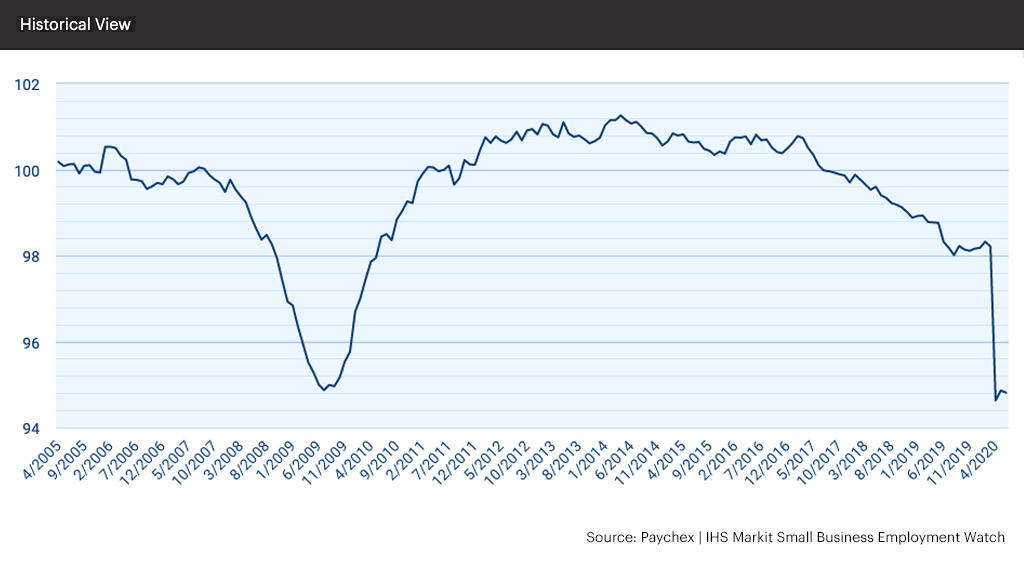
National Wage Report
- Reaching four percent in June, weekly earnings continue to trend upward as both weekly hours worked and average hourly earnings improved.
- Annualized one-month growth in weekly hours worked topped eight percent in June as more businesses reopened and employees returned to work.
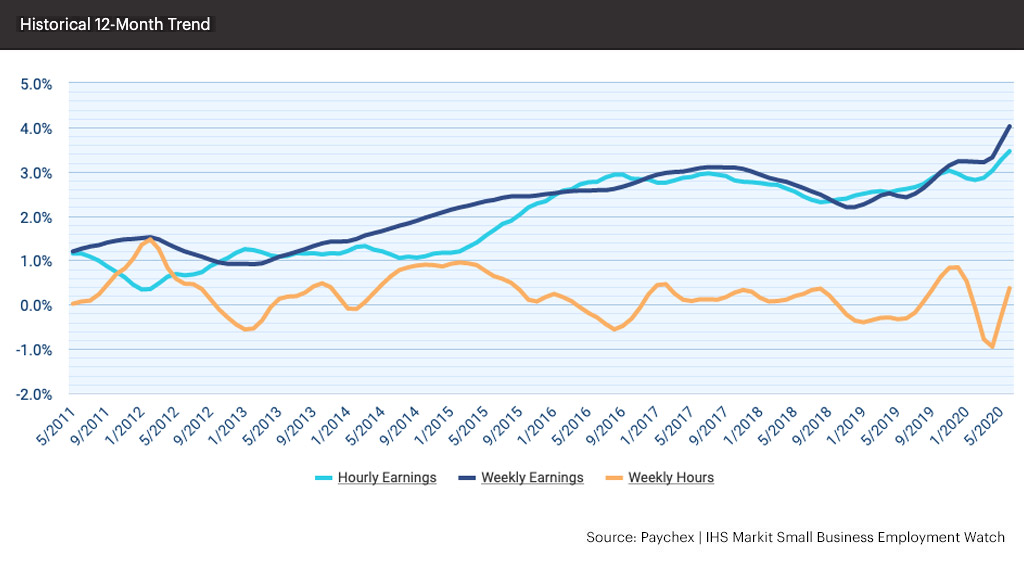
Regional Jobs Index
- Falling below 94 and remaining last among regions, the Northeast has dropped 4.40 percent during the past quarter, while all other regions posted declines of three percent or less.
- At 96.07, the South continues as the top region, well ahead of the next highest region, the Midwest, at 95.16.
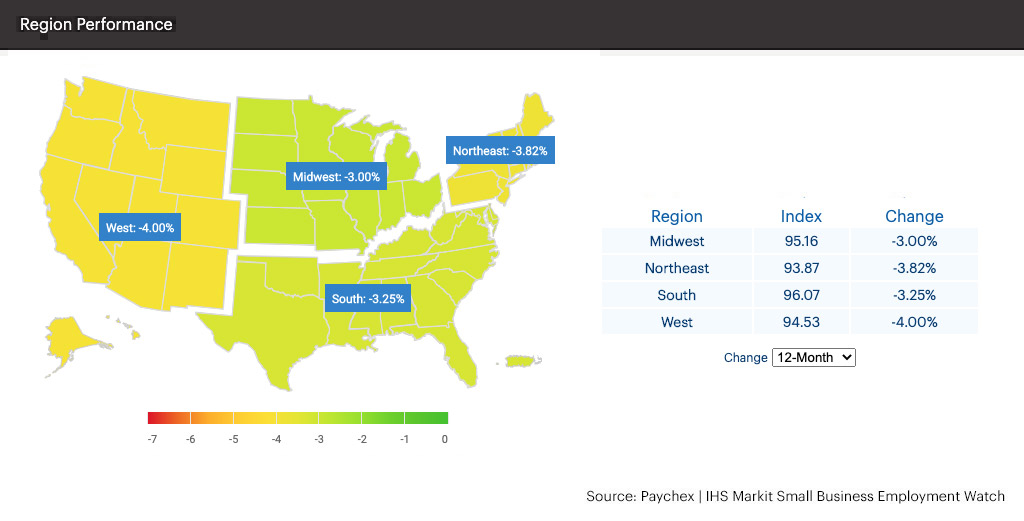
Regional Wage Report
- The hard-hit Northeast exhibited the largest gain in weekly earnings, 7.89 percent.
- At 2.81 percent, the South has the weakest hourly earnings growth rate among regions, partially attributed to its workforce stability throughout the pandemic.
- Down 0.62 percent year-over-year, the West is the only region with negative growth in weekly hours worked, though one-month and three-month annualized growth rates are signaling an upturn.
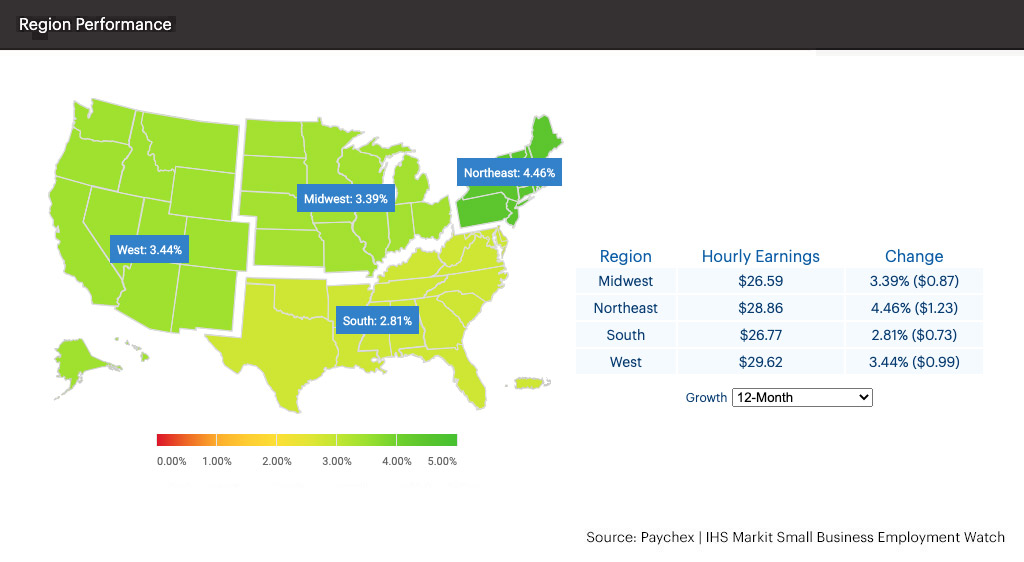
State Jobs Index
- Arizona gained 0.89 percent from May to June, boosting its index above 96 and trailing only Florida (97.60).
- One of the last states to shut down and the first to reopen, Florida saw its employment growth fall just 0.62 percent to 97.60.
- Indiana and Wisconsin suffered the largest setbacks in June, decreasing around one percent to index levels slightly above 95.
- The jobs index in New York remains the weakest (92.56) as the pace of small business employment growth has decreased nearly five percent during the past quarter.
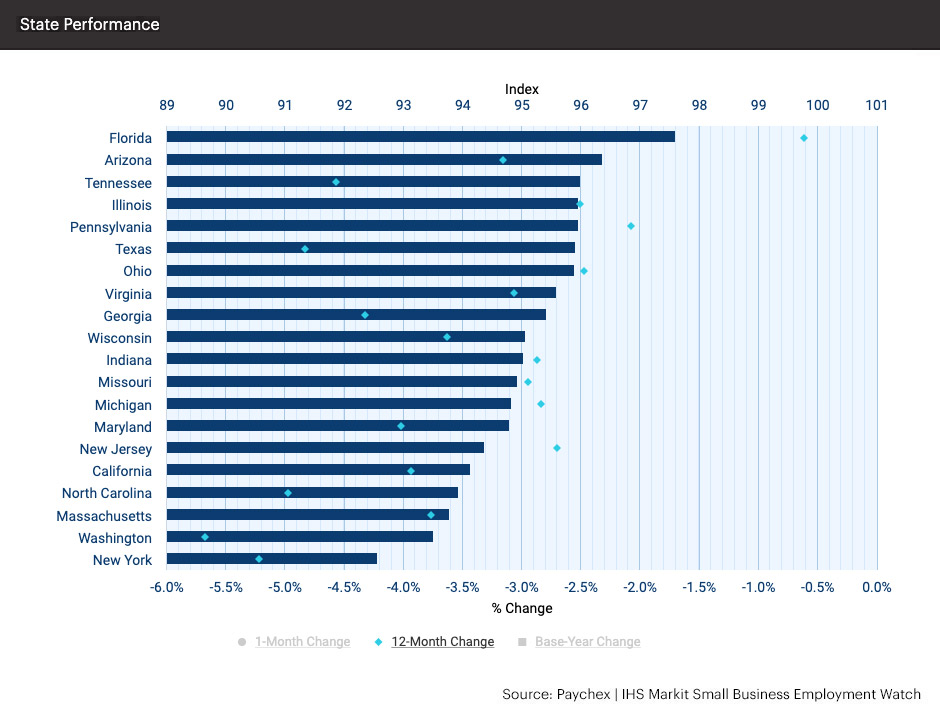
State Wage Report
- In the Northeast, Massachusetts, New Jersey, New York, and Pennsylvania scored significant weekly earnings gains from May to June, as did Michigan and Ohio in the Midwest.
- With fewer shutdowns and greater workforce stability, Texas ranks last among states in earnings and weekly hours growth.
- At 5.78 percent, New Jersey has experienced an uptick in hourly earnings growth in recent months.
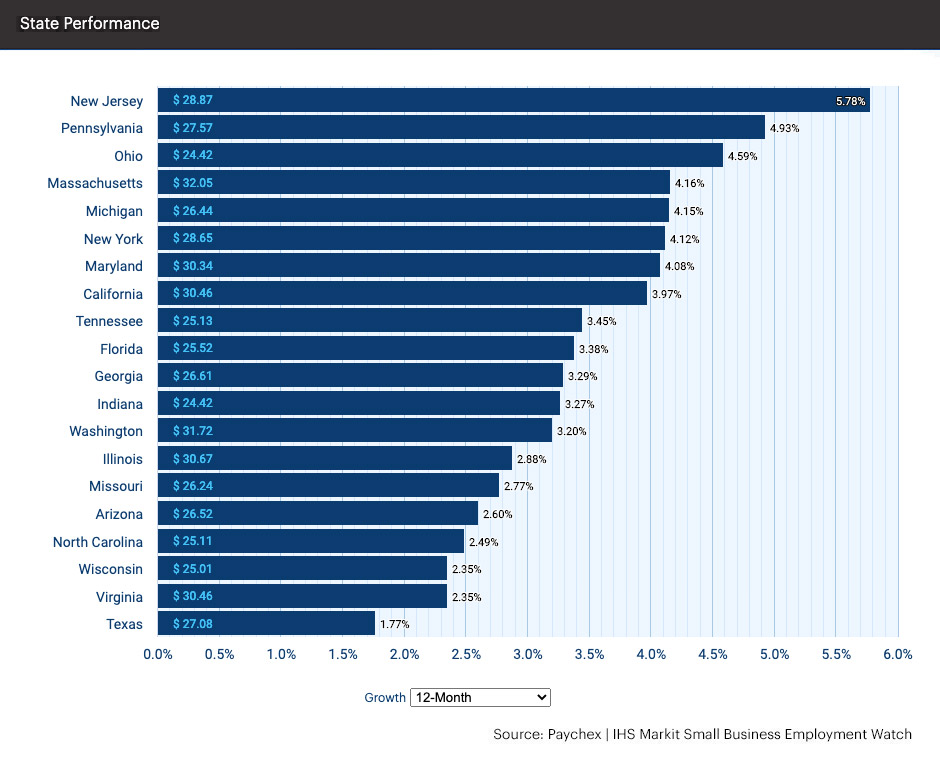
Metropolitan Jobs Index
- The Sun Belt cities of Tampa, Phoenix, and Miami led all metros in the level of small business job growth in June.
- Seattle and San Francisco trail all metros, with index levels at approximately 93 and year-over-year declines of more than five percent.
- Half of the metros analyzed have index levels below 95.
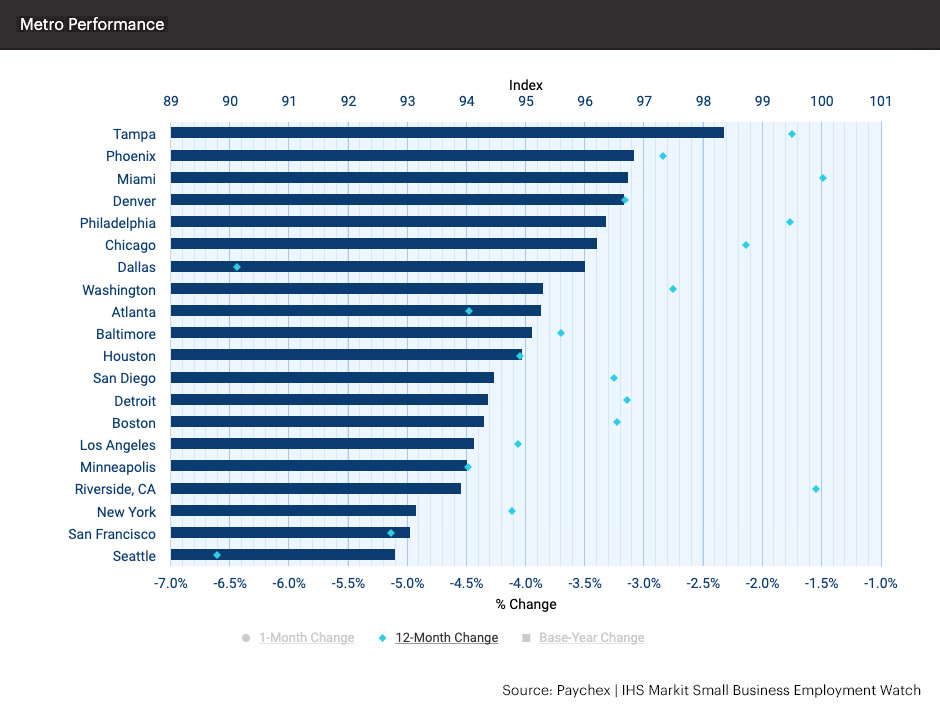
Metropolitan Wage Report
- Weekly earnings growth in Boston surged to 7.77 percent, best among metros, as one-month annualized growth from May to June increased nearly 25 percent with businesses reopening and increasing hours.
- Dallas and Houston are ranked last in all three wage components, with negative weekly earnings and hours worked growth
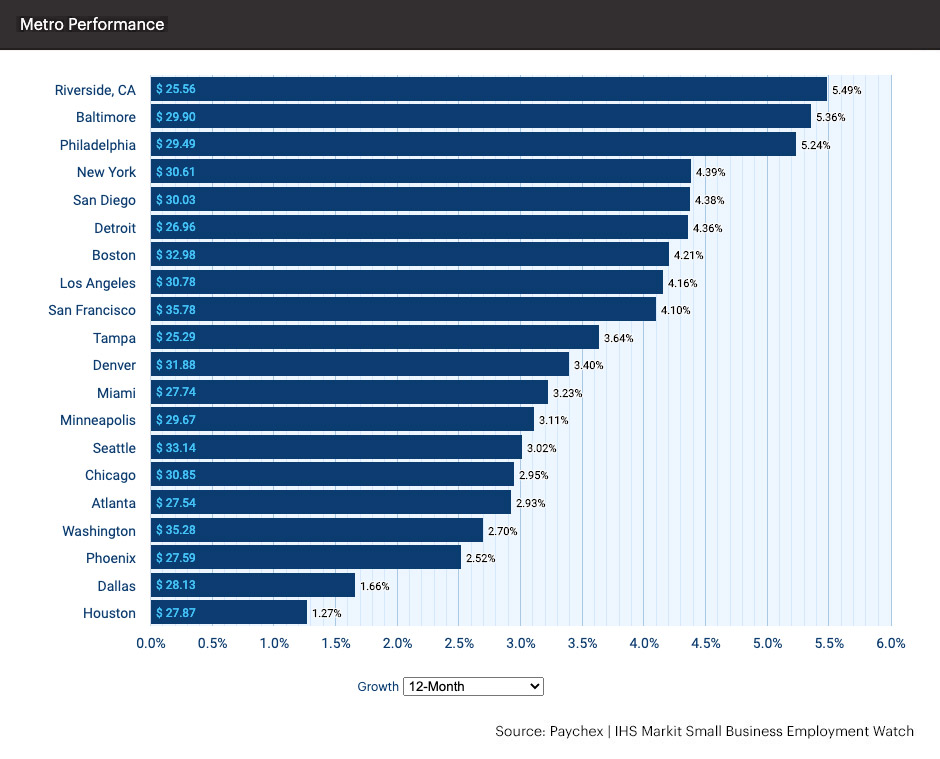
Industry Jobs Index
- At 89.63, Leisure and Hospitality is down 7.91 percent during the past quarter, reporting more than twice the losses of any other sector since the beginning of the coronavirus pandemic.
- Trade, Transportation, and Utilities rebounded slightly from its April and May lows, up 0.49 percent to above 94.
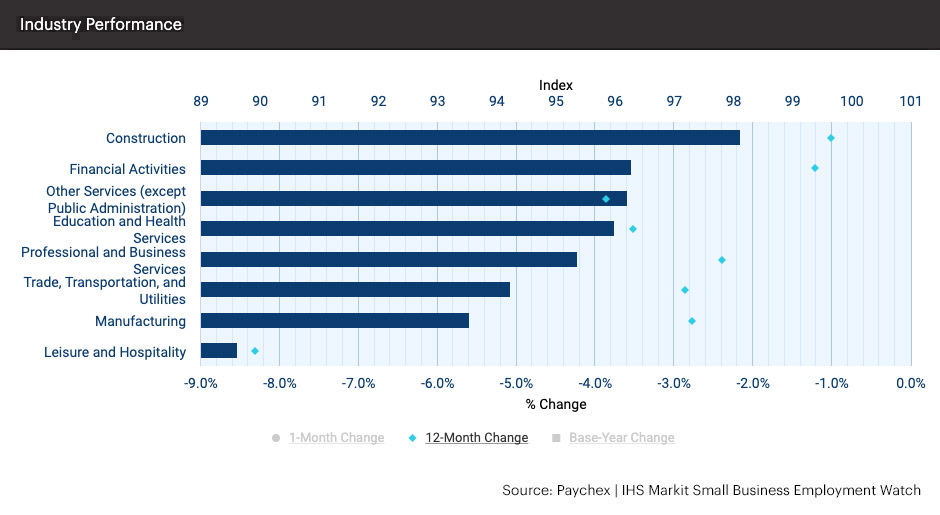
Industry Wage Report
- The impact of construction workers returning to job sites was evident in June with earnings gains above four percent in that industry.
- Education and Health Services has yet to recover, reporting -1.65 percent weekly earnings growth, nearly five percent below the next lowest industry, 3.10 percent (Manufacturing).
- The hardest-hit industry, Leisure and Hospitality showed sizable wage gains from May to June as businesses reopened; weekly earnings growth increased to 3.76 percent from the previous year.
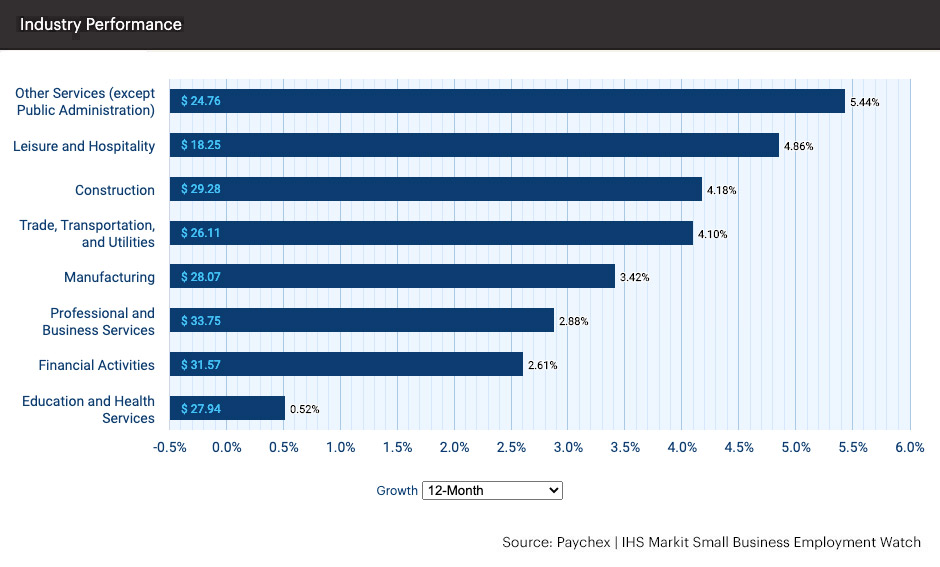
Note: Analysis is provided for seven major industry sectors.
